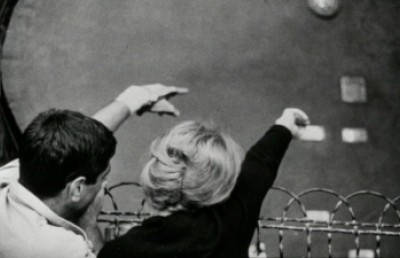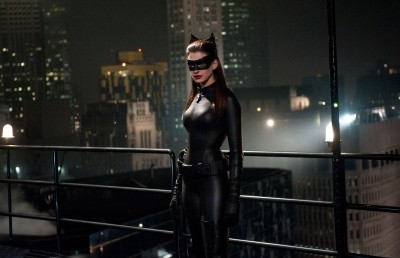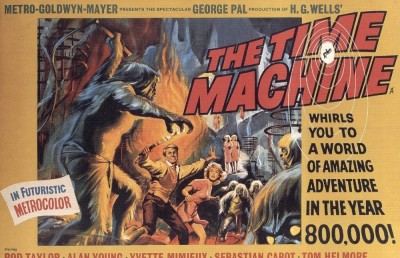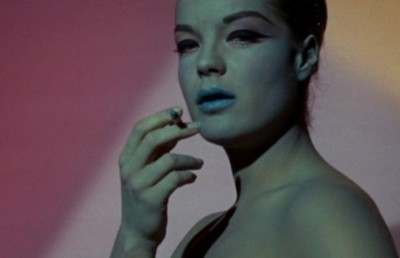Speculation Regarding the Future in Film: On The Road, Moon, District 9, and Other Films
Beauty, Intelligence, and Invention Express Values and Tactics
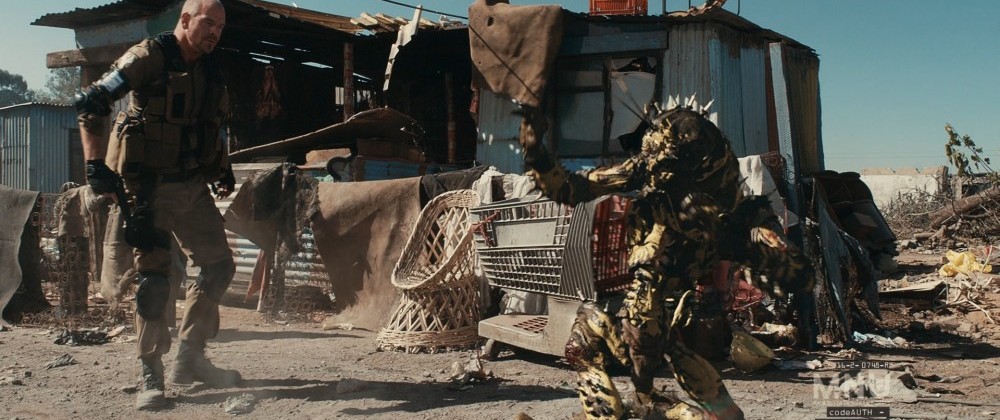
The Road, directed by John Hillcoat, is based on Cormac McCarthy’s novel The Road, and it is about the struggle for survival of a father and son after a cataclysm in which the world’s ecology has been destroyed and society has deteriorated to cannibalism. The locations used in the film were not invented, but found: places in our world that have already known natural and social destruction. The film is an allegory of family and the future, very much inspired by life as we know it.
It is easy for people who are imaginative or intelligent to believe in the future, as that is where we live, and what we live with: trains, automobiles, planes, rockets, phonographs, films, telephones, faxes, computers, microwave ovens, and other forms of technology—complex ideas once dreamed of, and turned into actual form and function—that would have seemed like magic to our ancestors but which for us are matters of science or, simply, matters of fact. We contemplate our world, with its explosion of population and increased use and transformation of the world’s resources. We look around us, and begin to think of what wonders or terrors tomorrow might bring; and some of our speculations are explored and expressed in books and films.
I recall, as a boy, seeing with my sister and cousins in the American south an old black-and-white film about the accidental launch of an American atomic bomb against Russia and the prospect of the United States allowing for the sacrificial destruction of an American city to make up for it and forestall the beginning of an annihilating war: Fail Safe. The film—which not very many people would assume is the kind of thing to interest children—captivated us, keeping us from going outside to play on a bright day. In years to come, still young, I would read books such as Alas, Babylon and Brave New World and 1984 and see movies such as Planet of the Apes and Soylent Green and television shows such as “Lost in Space” and “Star Trek.” While “Star Trek” tried to accept, and even promote, multiculturalism, Britain’s “Quatermass” evinced a great suspicion of young people and the social movements of the time, with young people suffering the early mind-distorting effects of a long-planned alien attack and old scientists coming to the rescue.
A movie like Planet of the Apes, starring Charlton Heston as an astronaut who has gone off course, offers both entertainment—the funny prospect of apes suddenly ruling the world—and penetrating metaphor, that of one social group dominating another and the elements of assumption and brutality that facilitate that domination. I just read an article on the intelligence of animals—some of which, such as Kanzi the ape, have been taught to communicate in sentences, using symbolic language—and I recall how various human populations—Native Americans, Africans, southern Europeans, Jews—have been defined and treated as other and lesser; and, thus, I know Planet of the Apes remains a fun and potent movie with real world associations. It is not the only one: from 2001: A Space Odyssey to Moon, films have brought the past, the present, and future possibilities together.
Many films—whether allegorical, fantasy, futurist, horror, science fiction, or speculative—have allowed us to visit what may come. As an adult film viewer, I have liked a lot of them, including Alien Nation, Blade Runner, Born in Flames, Brother from Another Planet, Dark City, Dune, The Fountain, The Happening, The Hitchhiker’s Guide to the Galaxy, Independence Day, Invasion of the Body Snatchers, Minority Report, Push, Starship Troopers, Twelve Monkeys, and White Man’s Burden. The short-lived television series inspired by the movie Alien Nation, about a human man-alien male police team, presented interesting scenarios centered on race, gender, and sexuality, as well as law and its transgression; and when the male alien gives birth while his wife is away, his human police partner lies next to, comforts, and holds the alien and his new baby. (A more recent television series out of Canada, “ReGenesis,” involving biological research and the fighting of disease, has a diverse cast, and includes a Latino gay male.) There used to be a paucity of African-Americans in futurist films, and the comedian Richard Pryor once said, “White people ain’t planning for us to be here,” but, increasingly—thanks to the presence of Will Smith and Laurence Fishburne and Angela Bassett, among others—that has changed.
Two of the most impressive speculative films have been The Matrix and Strange Days. I recall being really intrigued by Kathryn Bigelow’s Strange Days, which featured a recording device that allowed people to record and sell the emotions and sensations of their experiences (the experience of bathing or sex or murder could be recorded); and I saw that as an easy extension of the audio-visual and medical technology that already exists, but I recall a white male political economist friend scoffing at that. My friend, strangely, seemed to judge the future strictly by the present: he could not accept the scenario as the technology did not yet exist, a failure of imagination. In the film, Ralph Fiennes plays a man obsessed with that voyeuristic technology and a young woman in trouble, and he, a tormented, vulnerable man, is helped by a strong, generous woman, played by Angela Bassett, who also appeared in Contact. Fiennes and Bassett reversed gender assumptions; and I was moved by the torment Fiennes portrayed. I thought the relationship portrayed by Fiennes and Bassett had its idealism, but an African-American woman friend, an administrator-educator, rejected the relationship, seeming to think it another caretaker role for a black woman. She seemed to want the black woman in the film to be the object of desire. It remains fascinating to me what we bring, and fail to bring, to speculations of the future, and forms of art.
Part of what makes speculative films special, and difficult, is that any element can make them persuasive to one person, or dissuasive to another; and while that is true of all films, it seems more the case with speculative work, possibly because each of us is imagining the future and that is both practical and a matter of the deepest personal hope. Of course, the reality we see around us contains things we accept and reject—and the people who are likely to have the patience for sustained speculation probably remember that. In the film The Matrix by the Wachowski brothers (Larry and Andy), about a world in which computers have taken over and are using human bodies, kept in glass pods, as battery fuel, while providing those bodies with fantasies of ordinary life, we are told that human beings reject perfection and expect imperfection, distress, and frustration as part of ordinary life. The film—which became part of a diverse, satisfying trilogy—has beauty, intelligence, and invention: vision; and it was exciting for seeming to be about the present and the future simultaneously, about a world in which the system in which we live is manipulative and all encompassing, and collective subversive rebellion becomes necessary. In the film Keanu Reeves, an idiosyncratic actor, plays a computer nerd, Neo, who is seen by the eloquent Laurence Fishburne’s heroic Morpheus as a prophesized warrior; and the film shows us Neo’s liberation, training, and acceptance of his role. We see human ingenuity in a computer world, and it is exhilarating.
Films, like books, or music, can seem to be variations on a theme. In Stanley Kubrick’s 2001: A Space Odyssey, a film with great imagery and compelling order, we observe our ape ancestors begin collective existence, and encounter a foreign (seemingly advanced and alien) intelligence, and find crude tools for hunting, an instrumentality that in time becomes or creates the well-armed technological future. In the film, two men work on a ship with a self-aware talking computer, while their colleagues sleep to be awakened when they reach their destination, an attempt to locate the alien intelligence that early man encountered. The simplicity of life onboard—the jogging of one man, the sketching of another, and the eating and work by both men—presents a routine that makes the future believable. Once the computer makes a mistake and understands the ship’s staff feels distrust and is considering dismantling his power, the computer begins to defend himself, which includes murder. It is a worst-case scenario of what a computer can do, even as the film ends with a complex contact with alien life that, ultimately, appears to allow man to see himself and his own transformations. Man lives, he eats, he sleeps, and he is no freer than he ever was; and that is not unlike much of The Matrix or of Moon.
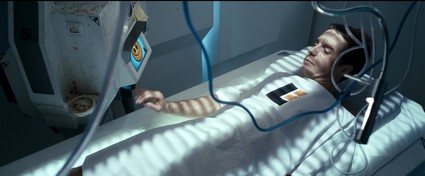
Moon
In Moon, a film directed by David Bowie’s son Duncan Jones, a film with ship imagery reminiscent of 2001, a solitary man working in a mining operation on the moon prepares to return home at the end of his three-year contract. Thanks to an accident, his replacement arrives before he leaves; and both men realize they bear a too-close resemblance to each other, and search for the explanation for that. Will either ever make it home? Has technology made for the easy creation and destruction of human life? Sam Rockwell stars in the film, and is able to be funky and laidback on one hand, and professional and tough on the other; and we see loneliness and terror, death and freedom, as the film continues. The somewhat dusty computer that works with the lead character here in this funny-sad film, a computer to which a yellow post-it note saying “kick me” has been attached, actually serves the man.
However, Neill Blomkamp’s District 9, though it contains references to alien technology and human science experiments, is a return to the kind of symbolism of Planet of the Apes; as in District 9, a spaceship hovers over a town in South Africa, the ship’s inhabitants having survived a plague that seems to have killed its commanders, and the inhabitants, who look like tall crustaceans or insects—they are called prawns by humans—are obviously a different species and are placed in a ghetto and treated badly. There is irony in having the white officials of the government supervise the control (the housing and the abortion) of the aliens, and have black township people complain of the alien presence. We have seen these acts and attitudes before, in South Africa and elsewhere. The film turns on the contamination of a white male government official with alien technology and biology, which begin to transform him—a regular guy, attractive, professional, and casually callous (played by Sharlto Copley)—into one of them; and one of the first rumors about him, when he becomes a valuable, sought-after fugitive, is that he has had sex with the aliens and has contracted a disease. The transformed man is sought for his new abilities, as an object for research and as someone able to use the powerful alien technology. The film, shot in run-down ghetto locations and acted with conviction, becomes a chase-and-elude and battle story, which is less interesting than the situation or symbolism, but it ends with what might be tragedy: a human who looks other.
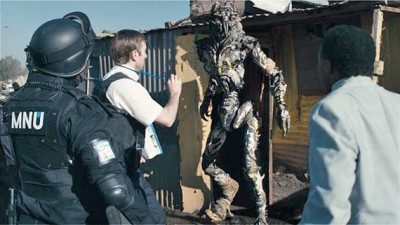
District 9
The simplest—and the most terrible—vision of the future is contained in the film The Road. In it, the organized, sophisticated world has been destroyed, with the land poisoned; and people scrounge through ruins looking for shelter and food, afraid of roving bands of armed cannibals. A father and son walk, afraid, dirty, hungry, going south, hoping to find something different there—warmth, if nothing else. The father tries to protect his son, while preparing the son to survive without him: the father, of course, shares what food and drink he finds, as well as tactics and values. The father wants his son to be humane without being vulnerable or weak; and there is tension there. Do they dare to help an old man who needs help? Do they exact revenge on someone who steals from them? The son is inclined toward sympathy, and the father is not; and there is division between them as the son’s values begin to conflict with the father’s preferred tactics. That is a story that is ageless, even as it takes place here, in this dark, touching film.
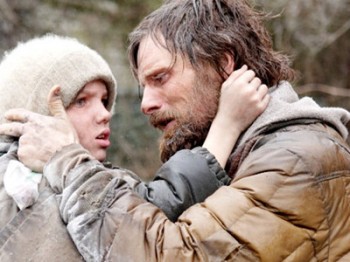
The Road
With the diversity of films in different genres available—from before the 1938 W.S. Van Dyke II Marie Antoinette, with its attention to the suffering of the French people and the excesses of the revolutionaries as well as the travails of the royal family, to the 2006 Sofia Coppola Marie Antoinette with its more narrow focus on the sweet appeal of royal perks and one woman’s confusion, to now—it can be difficult to make an argument for the unique significance of speculative films that take the future or science as subject. All art—not entertainment, but art, which is what lasts—comments, creates, documents, and observes; all art speculates; and all art, for which men and women seem to tear out their hearts and guts to tell us things we usually do not want to hear, is eternal, whether it is set in the past, present, or future.
There is speculation in Constellation, The Edge of Love, Forgetting Sarah Marshall, Gran Torino, The Great Raid, Little Children, The Messenger, Nothing But the Truth, The Other Man, The Reading Room, The Savages, Shutter Island, and Up in the Air, as there is in Citizen Kane and Wild Strawberries and other respectable films; speculation of various kinds. Read a Platonic dialogue, Shakespeare, Henry James, or Toni Morrison, and the characters, arguments, and situations live for you now. Listen to Beethoven, the Beatles, or Beyonce, and your experience of music is current, of the present moment. Yet, in their invention of a possible future, certain speculative films offer us solutions to problems, intellectual and social problems: those are more than beauty, more than experience—those are philosophical and pragmatic interventions. Often some of the solutions—ways of acquiring knowledge, instituting morality, controlling population growth, or extending life—produce negative effects that encourage us toward flexibility, generosity, patience, and tolerance of mystery. The films revolve around stories of crises, and I suspect that is because many people do not question their fundamental philosophy unless there is a crisis.
Speculative films about the future tend to ask us more nakedly, more persistently, than most other kinds of films: what kind of people do we want to be, what is worth knowing and doing, and what kind of future do we want to live in, and how can we change ourselves and the world?
In the film The Road, we cannot be sure of how much of the destruction we see is natural and how much technological. The destruction is, inevitably, a warning, but focus is on the human response; and on how one father and son try to live, decently, with love for each other. As long as they can refuse brutality—whether cannibalism or simple cruelty—there is hope for the reconstitution of human society.
The father (Viggo Mortensen) and son (Kodi Smit-McPhee) once belonged to a family, but the despairing wife and mother (Charlize Theron), a beautiful woman who was a pianist, cannot tolerate mere survival. The destruction of her piano for firewood is one of the most discouraging moments for her. She leaves her husband and son one night, walking into the cold, expecting death. For the father, his son is his hope both for himself and the world. The rough-and-tender father and the shy, sometimes forceful son outrun hunters, find a house with a storage of food and fuel and they eat and bath and for a short time have an experience of domestic life, but, hearing a disturbance, the father believes the place is unsafe and they take to the road again. They meet and feed a raggedy old man (Robert Duvall), and have their things stolen, and find themselves shot at by an archer who believes they have been following him. It is a world in which the only moral compass is personal; a world of anarchy and desperation, in which private conviction is tested daily. Is what the father has given his son—in ethics, in love, in strategy–enough? And, what will you hand on to those who have come, or will come, after you, who may live a future you only can imagine?


